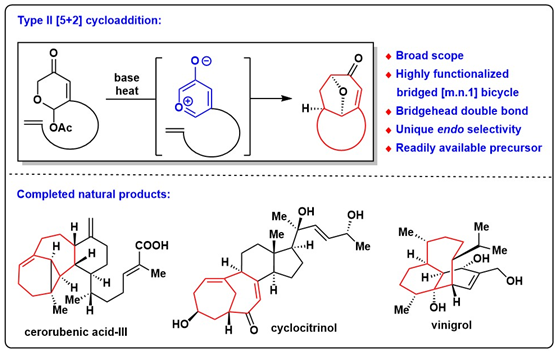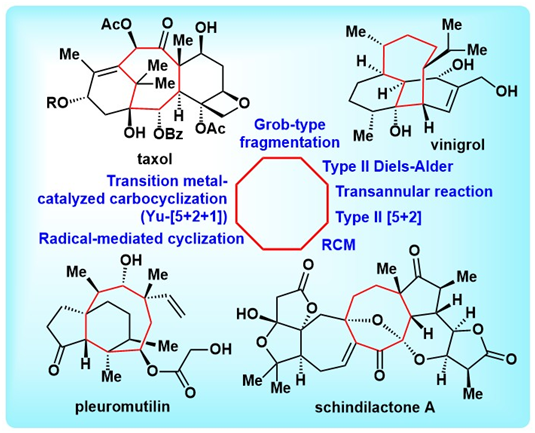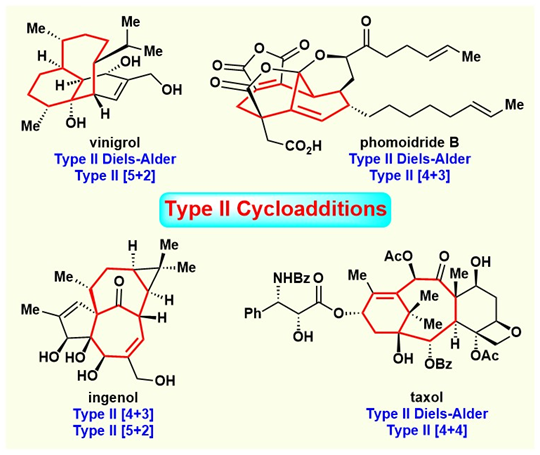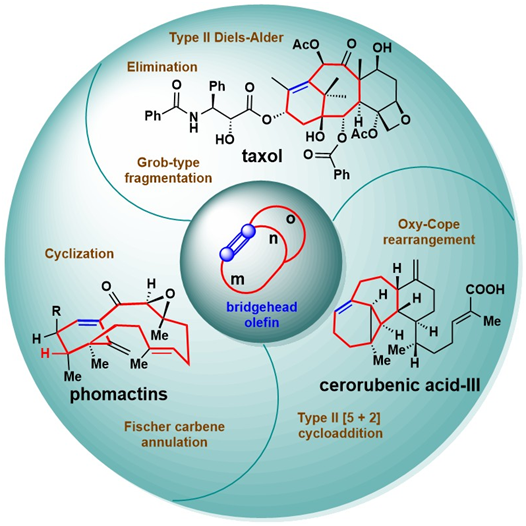Professor Chuangchuang Li (Chemistry) is renowned for his studies in the total synthesis of complex natural products. In recent months, his research team has been invited to publish review articles in Accounts of Chemical Research (IF = 20.8), Chemical Reviews (IF = 52.8), Chemical Society Reviews (IF = 42.9), and Chem (IF = 19.7). Dr. Chuangchuang Li was the corresponding author, with SUSTech as the corresponding unit of all four papers.
The paper published in Accounts of Chemical Research was titled, “Total Synthesis of Natural Products with Bridged Bicyclo[m.n.1] Ring Systems via Type II [5 + 2] Cycloaddition.” The article summarized the use of Type II [5+2] reactions to complete several successful total synthesis cases of complex active natural products (Figure 1).

Figure 1. Type II [5+2] cycloaddition reaction total synthesis application
The research group developed the reaction for the first time in 2014, which solved the problem of how to construct a bridge ring system efficiently. Following five years of exploration, they have developed a modular and systematic solution that successfully achieved the first total synthesis of several extremely challenging natural products.
Research Assistant Professor Long Min and Dr. Xin Liu were the co-first authors of the paper. The invitation to publish in Accounts of Chemical Research represents the high quality and impact of scientific research being conducted by the research group.
The article published in Chemical Reviews was titled, “Recent Advances in the Total Synthesis of Natural Products Containing Eight-Membered Carbocycles (2009–2019)“. It sought to examine the progress made in the total synthesis of complex natural products containing eight-membered carbon rings over the last ten years (2009-2019) (Figure 2).

Figure 2. Progress in the total synthesis of natural products with eight-membered rings
The researchers focused on the synthetic strategies of twenty-seven cases of total synthesis of natural products. They attempted to extrapolate into the future for this field.
Doctoral students Yajian Hu and Luxian Li, Grubbs Research Institute Research Assistant Professor Jingchun Han, and Research Assistant Professor Long Min were the co-first authors.
Chemical Society Reviews published “Synthetic applications of type II intramolecular cycloadditions.” It is the first systematic summary in nearly 40 years of the highly efficient Type II cycloaddition reaction. It constructs bridged ring systems and their applications in the total synthesis of natural products (Figure 3).

Figure 3. Total synthesis application of Type II cycloaddition reaction
The research group hypothesized the naming method of Type II cycloaddition reactions. It systematically summarized all four types of Type II cycloaddition reactions, their methodology development, and the total synthesis application. The research group assessed the advantages and disadvantages of each methodology. The analysis and comments emphasized that these pioneering research work provided essential ideas for synthetic chemists to develop new Type II cycloaddition reactions.
The research group called on synthetic chemists to actively adopt Type II cycloaddition strategies for synthesis. More active natural products with bridged ring structures provide a powerful boost to the development of this field.
Research assistant professor Long Min and doctoral students Yajian Hu, Jianhong Fan, & Wen Zhang are the co-first authors of the paper.
The final paper in question was published in Chem, under the title of “Total Synthesis of Natural Products Containing a Bridgehead Double Bond.” The article looked at the progress made in research into the total synthesis of natural products with bridgehead double bonds (Figure 4).

Figure 4. Progress in the total synthesis of natural products with bridgehead double bonds
In the article, the research group summarized seven methods for building bridgehead double bonds before analyzing each method. The group concluded that while there are several methods and strategies for constructing different bridgehead double bonds, more research is needed to explore more efficient and concise synthetic methods.
AAIS Research Assistant Professor Junyang Liu, Dr. Xin Liu, and doctoral student Jianlei Wu are the co-first authors.
The research papers received funding from the Leading Talents of the Special Support Program of the Central Organization Department, the National Natural Science Foundation of China, the Shenzhen Science and Technology Innovation Commission, and SUSTech.
Proofread ByYingying XIA
Photo ByDepartment of Chemistry, Yan QIU